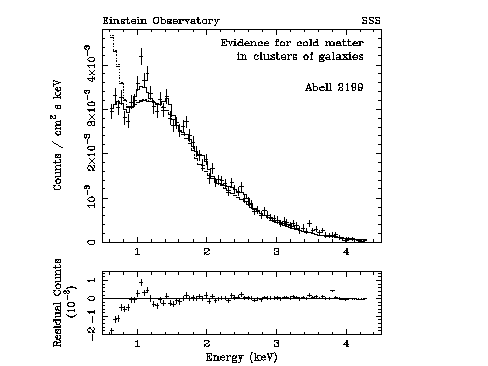|
|

Number 1 May 1992

On the cover An analysis of the Einstein Observatory Solid State Spectrometer data from clusters of galaxies has recently been reported by White, D.A., Fabian, A.C., Johnstone, R.M., Mushotzky, R.F. & Arnaud, K.A. 1991, Mon Not R. astr. Soc, 252, 72. The new SSS ice model enabled significant excess absorption above that due to the line-of-sight through the Galaxy (from 21 cm measurements) to be detected in 12 out of 21 clusters studied. This excess absorption is most likely due to cold clouds and represents a significant new component to the intracluster medium. The cluster spectra requiring excess absorption also require significant cooling flow components, implying the absorption may originate from mass deposited through the cooling flow region of the clusters. The front cover (upper panel) shows the SSS spectrum of the central region (3 arcmin radius), of NGC 6166 in A2199. The model spectra shown by the dotted line indicate the best-fitting thermal model with Galactic absorption only and the solid line represents the best-fitting thermal and cooling flow model with additional absorption. The lower panel shows the residuals for the bremsstrahlung spectral model which best fits the A2199 above 1.57 keV, extrapolated to lower energies. Galactic absorption only has been assumed. Evidence for the excess absorption is clearly visible in the negative residuals below 1 keV, as is evidence for additional line and continuum emission from the cooling gas by the positive peak in the residual around 1 keV.
Goddard Space Flight Center
 Proceed to the next article
Proceed to the next article
 Return to the previous article
Return to the previous article
HEASARC Home | Observatories | Archive | Calibration | Software | Tools | Students/Teachers/Public Last modified: Monday, 19-Jun-2006 11:40:52 EDT |



 Select another article
Select another article